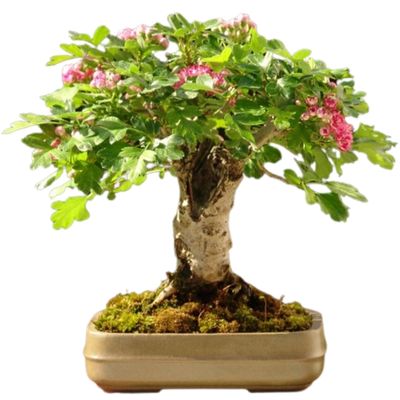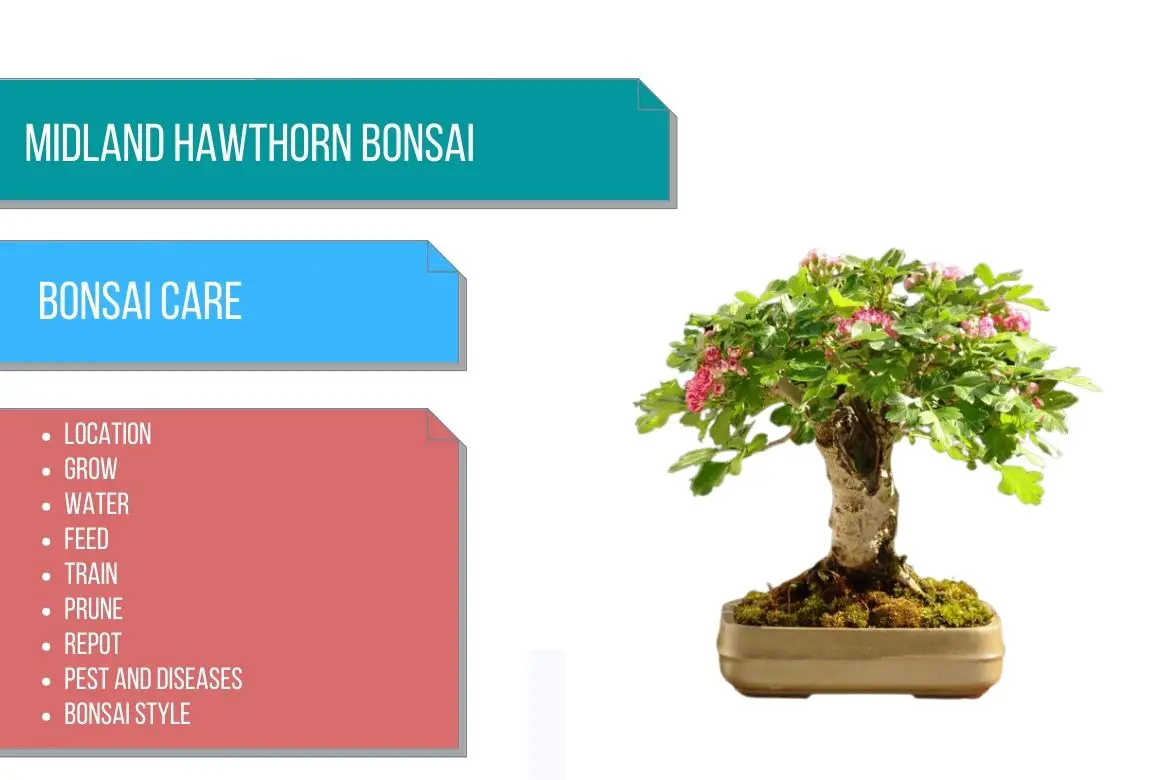
Midland hawthorn / English hawthorn
(Crataegus Laevigata)
Country of Origin : United Kingdom and Europe
Bonsai Styles : Informal upright, semi-cascade
Zone : 4
Midland Hawthorn (aka English hawthorn or woodland hawthorn) is a small hardy deciduous tree.
Typical of the growth habit of most of the shrubs, it has spiny branches. The leaves of the tree have 2-3 shallow, forward-pointing lobes (typically mildly lobed, rarely reaching half way up the midrib). The tree is mainly grown for its flowers as the leaves have little to no fall color.
There are many varieties of Midland Hawthorn. Depending on the variety, the tree can produce single or double flowers. The color of the flowers can range from white, pink to bright crimson.
Midland Hawthorn makes a beautiful and easy to train flowering bonsai tree. It is suitable for pretty much all bonsai styles except formal upright and broom style.
Another common variety of hawthorn that can be used to make a bonsai is Crateagus monogyna (common hawthorn). The main difference between C. laevigata and C. monogyna is that C. laevigata is less vigorous and does not set fruit as easily.
Read more about other bonsai trees species in : Types of bonsai tree
Best location to keep Midland hawthorn bonsai tree
During the growing season, this species can be kept in full sunlight. However, in very hot temperatures, this species would benefit from some shade as well.
Ensure that flower buds are protected from frost in the late spring.
Protect smaller bonsai trees from frost.
IMP: Refer to do bonsai trees need sunlight for more indoor and outdoor bonsai location ideas. Also, refer sunlight requirements for indoor plants for more indoor gardening ideas.
Propagation of Midland hawthorn bonsai tree
Midland hawthorn can be propagated by using seeds and cuttings. Some growers use grafting to start a good bonsai specimen.
You can take hardwood or softwood cutting in summer or winter. Make sure that the cutting taken doesn’t have any fruit or flower. (summer cuttings).
Cuttings planted in summer will take almost 30 days to root sufficiently.
When taking winter cuttings, choose a stem which which has a dormant leaf bud. Plant the stem cutting. This should have sufficient roots in the spring.
Apply rooting hormone to the cuttings.
While sowing seeds, make sure that you sow it in a clean area. Or else mildew can pose some problems.
Watering Midland hawthorn bonsai tree
It is very important to generously water Midland hawthorn bonsai on a regular basis, especially during the growing season.
Bonsai soil should never dry out completely at any time, since this can lead to dieback in the bonsai.
It is important to keep the soil just moist during the winter months.
You should also mist the plant. This will prevent mildew.
Read watering bonsai tree for more details and also about bonsai water immersion technique.
Wiring Midland hawthorn bonsai tree
Wire training can be done on new shoots of the tree from mid- to late summer.
The wire should be left on the tree for no more than one year.
Read : Detailed guide on How to wire a bonsai. This extensive guide includes all the wiring techniques and Do’s and Dont’s. It will also show you other bonsai training techniques which can be achieved without using wires.
Pruning Midland hawthorn bonsai tree
When to prune Midland hawthorn bonsai tree?
How to prune Midland hawthorn bonsai tree?
In spring, it is a good idea to pinch out the terminal shoots. After the flowers have faded or after the leaves have fallen, prune the branches.
Old shoots should be pruned back after flowering in order to promote the growth of new flowering shoots.
The old shoots should be left if you want to encourage berries to grow on your plant. But keep in mind that this tree doesn’t set fruit so easily when grown in a pot.
There will be many new shoots growing from the existing branches, which will carry the flowers for the following year.
In order to maintain the shape of the plant, prune or pinch out any growing tips as necessary. It is recommended, however, that pruning or pinching should not be done excessively after midsummer.
In case your tree was grown by grafting, you must prune suckers that sprout from the roots soon after noticing them.
Remove the dead branches in case of dieback (caused by insufficient watering or a shallow pot). Or you can even keep these dead branches for a driftwood effect.
Read how to prune a bonsai to know about the right technique of pruning and more about defoliating a bonsai tree.
Repotting Midland hawthorn bonsai tree
When to repot Midland hawthorn bonsai tree?
Young Midland hawthorn bonsai tree should be repotted every year. However, mature bonsai specimens can be repotted every 3 to 4 years. Repotting can be done in early spring.
You can repot the tree every Ensure that the soil is free-draining. It is not important what type of soil you use for hawthorns, as long as it drains well. A basic regular commercial bonsai soil mix should be good enough.
Using a shallow pot will cause die-back of the crown. Use a deeper pot.
You can also use sharp sand, loam, and peat (or garden compost) in the ratio of 1:2:1.
Please check out how to repot a bonsai to know everything about repotting and root pruning a bonsai.
Must Read: Bonsai Soil Recipes
Must read : Choosing the right bonsai container
Feeding Midland hawthorn bonsai tree
During the growing season, you should feed the Crataegus Laevigata bonsai twice a month.
Read more about bonsai fertilizer and its application. This will also give you more details on how to feed flowering bonsai trees.
Diseases and pest of Midland hawthorn bonsai tree
Midland hawthorn bonsai are prone to black spot and rust. Control can be achieved with the application of appropriate fungicides.
Our comprehensive guide: How to identify and treat bonsai pests and diseases is a great resource for you to see all the organic and inorganic remedies you can use.

